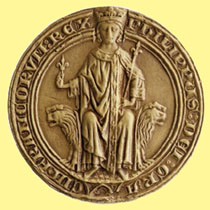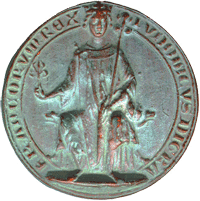
![]() Royal
Seals. Seals were created by the Merovingian kings.
Early ones were seal-rings. Later Royal French seals grew
bigger under the Capetian Dynasty to reach around 12 centimetres,
the same dimensions as the modern Seal of State of France.
Royal
Seals. Seals were created by the Merovingian kings.
Early ones were seal-rings. Later Royal French seals grew
bigger under the Capetian Dynasty to reach around 12 centimetres,
the same dimensions as the modern Seal of State of France.

![]() Seals
under the Ancien Régime showed the king sitting on
this throne and dispensing justice. All edicts, orders,
decrees and declarations were sealed. As in other European
monarchies, each king had his own seal, created at his accassion
and destroyed at his death.
Seals
under the Ancien Régime showed the king sitting on
this throne and dispensing justice. All edicts, orders,
decrees and declarations were sealed. As in other European
monarchies, each king had his own seal, created at his accassion
and destroyed at his death.
Click on the following link for information on the
Seal of King Louis IX ![]()
The Ancien Régime used a green wax for important documents, and a yellow for less important ones.
The Seal of the Republic (The Seal of State). The present Great Seal of France dates back to 8 September 1848 - the Second Republic. The Second Republic had briefly used the Seal of State of the First Republic, which featured a Phrygian cap (or Liberty Cap), before having a new design created by the artist Jacques-Jean Barre.

![]() The
seal shows on the obverse a female figure representing Liberté
(Liberty). She is personnified as Juno (Hera) seated,
robed and wearing a crown of seven arches. This is the same
crown that is so familiar from the Statue
of Liberty Enlightening the World, a gift from the French
to the American
people. On the Great Seal she holds a fasces,
an ancient symbol representing civic authority that also
features on the arms
of the French Republic. She leans on a the tiller of
a ship's rudder, a reference to government (the word govern
originally meant "to steer"). On the rudder a
cockerel
is depicted, one claw resting on a globe (presumably representing
French domination of the world). Behind the rudder is an
oak branch (a symbol of long life). At her feet is an urn
with the letters "SU" on it. They stand for "Suffrage
Universel" (Universal Suffrage) - the urn was the classical
equivalent of a ballot box. In the background, on her right,
are a painter's easle and paint brushes (symbols of the
Arts), a plough and wreaths of wheat (representing agriculture)
and a cog wheel (representing industry). The representations
of industry and agriculture are echoed in the later hammer
and sicle that feature in socialist Soviet iconography.
The
seal shows on the obverse a female figure representing Liberté
(Liberty). She is personnified as Juno (Hera) seated,
robed and wearing a crown of seven arches. This is the same
crown that is so familiar from the Statue
of Liberty Enlightening the World, a gift from the French
to the American
people. On the Great Seal she holds a fasces,
an ancient symbol representing civic authority that also
features on the arms
of the French Republic. She leans on a the tiller of
a ship's rudder, a reference to government (the word govern
originally meant "to steer"). On the rudder a
cockerel
is depicted, one claw resting on a globe (presumably representing
French domination of the world). Behind the rudder is an
oak branch (a symbol of long life). At her feet is an urn
with the letters "SU" on it. They stand for "Suffrage
Universel" (Universal Suffrage) - the urn was the classical
equivalent of a ballot box. In the background, on her right,
are a painter's easle and paint brushes (symbols of the
Arts), a plough and wreaths of wheat (representing agriculture)
and a cog wheel (representing industry). The representations
of industry and agriculture are echoed in the later hammer
and sicle that feature in socialist Soviet iconography.
The scene is surrounded by the legend "RÉPUBLIQUE FRANÇAISE, DÉMOCRATIQUE, UNE ET INDIVISIBLE" ("French Republic, democratic, single and indivisible") and "24 FEV. 1848" (February 24, 1848) at the bottom. The latter is the date that a provisional government was established in Paris after a mob had attacked the Tuileries.
The reverse bears the words "AU NOM DU PEUPLE FRANÇAIS" ("in the name of the French people") surrounded by a crown of oak (a symbol of long life) and laurel (a symbol of glory), the leaves tied together by weed and grapes (representing agriculture and wealth), with the motto of the French Republic "ÉGALITÉ, FRATERNITÉ, LIBERTÉ".
 You
will see representations of the Liberty figure marking the
offices of Notaires throughout france. They also use seals
- stamps really - with a simple representation but with
all the main features visible, as shown on the right.
You
will see representations of the Liberty figure marking the
offices of Notaires throughout france. They also use seals
- stamps really - with a simple representation but with
all the main features visible, as shown on the right.
History of the modern Seal. After the abolition of Monarchy and installation of the First Republic on the 21st September 1792, the the royal seals seals were broken and sent to the Mint (called the Monnaie in France) where seals and coins were made. In the same month Danton, then Minister of Justice, had the first seal of the Republic struck: Liberty standing, supported by a fasces, holding a spear and wearing a phrygian cap.
Napoléon, Louis XVIII and Charles X all took back the royal seal of majesty, Louis-Phillipe showing only his bust.
![]() Under
the Second Republic, when the present Great Seal of France
was adopted, usage of the seal was generally restricted
to sealing new laws, decrees of the National Assembly and
diplomatic treaties. The function of Keeper of the Seals
("Garde des Sceaux") was linked to that of Minister
of Justice at that time. This explains the modern usage
of the title Garde des Sceaux for the French minister
of Justice.
Under
the Second Republic, when the present Great Seal of France
was adopted, usage of the seal was generally restricted
to sealing new laws, decrees of the National Assembly and
diplomatic treaties. The function of Keeper of the Seals
("Garde des Sceaux") was linked to that of Minister
of Justice at that time. This explains the modern usage
of the title Garde des Sceaux for the French minister
of Justice.
After the Second Empire, the practice of applying seals to new laws was abandoned and the use of the Great Seal was restricted to constitutional acts and diplomatic treaties. The Treaty of Versailles for example was sealed in this way.
Under the Fourth Republic, the only document to be sealed was the Constitution of the 27 October 1946. Usage of the Great Seal become obsolete between 1920 and 1946, and during that period the recipe for the wax was lost. In 1946, trials had to be made by the Sigillographic service of the National Archives to find a new recipe.

![]() Under
the Fifth Republic, the Constitution of the 4 October 1958
was sealed. It became common practice to seal subsequent
constitutional modifications.
Under
the Fifth Republic, the Constitution of the 4 October 1958
was sealed. It became common practice to seal subsequent
constitutional modifications.
Sealing ceremonies are held at the Chancellerie where the Garde des Sceaux (Minister of Justice), holds a sealing press and the matrices of the Seal of theState. Liquid wax is fed directly into the inferior part of the mould made of a stamp and a mobile metallic ring; the mould is closed and the wax cools down until it becomes pasty before it is applied. Since 1946 red wax has been used.
The French Seal of State is one of the gererally recognised symbols of sovereignty not mentioned in article 2 of the French Constitution of 1958, which refers only to le drapeau tricolore, bleu, blanc, rouge: The French Flag , L'hymne national, the national anthem, The Marseillaise and La devise de la République; the motto . "Liberté, Égalité, Fraternité".





